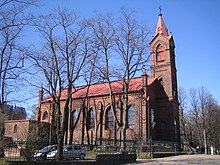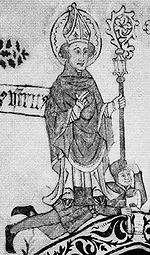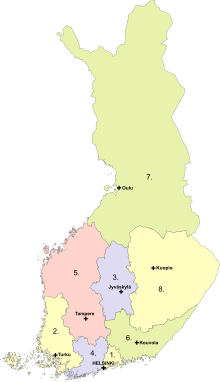Catholic Church in Finland
| Part of a series on the |
| Catholic Church by country |
|---|
 |
|
|

The Catholic Church in Finland is part of the worldwide Catholic Church, under the spiritual leadership of the Pope in Rome.
As of 2018 there are more than 15,000 registered Catholics in Finland of total 5.5 million population of the whole country and also estimated about 10,000 unregistered Catholics in the country. More than 6000 Catholic families are there in the total country where 50 percentage is Finns and rest is International community. [1] As of 2018 there are only five Finland-born priests, and only three of them work in Finland. The Bishop of Helsinki is vacant. Currently there are more than 30 priests working in Finland from different countries.[2]
Due to the small number of Catholics in Finland, the whole country forms a single diocese, the Catholic Diocese of Helsinki.
The Catholic Church in Finland is active in ecumenical matters and is a member of the Finnish Ecumenical Council, even though the worldwide Catholic Church is not a member of the World Council of Churches.[3]
History[]

Catholicism was the first form of Christendom that entered the area of Finland. Earliest finds of Western-Christian (Catholic) artefacts date from the 11th to the 12th century. In the 16th century Finland, as part of Sweden, took part in the Lutheran reformation after which Catholicism lost almost all ground in the area.
The first Catholic religious service following the death of the Catholic John III of Sweden was held in 1796 by the apostolic vicar of Stockholm, the Italian-born Father Paolo Moretti.[citation needed]
The parish Vyborg was established 1799 in the Russian part of Old Finland. After the rest of Finland became part of the Russian Empire in 1812, the parish covered the whole Grand Duchy of Finland. There were about 3000 Catholics in 1830. All the priests until the 1860s were Lithuanian Dominicans. The parish of Helsinki was founded 1856, possibly due to the influence of the General Governor Friedrich Wilhelm von Berg's Italian wife, Leopoldina Cicogna Mozzoni (1786 -Warsaw 17 February 1874). St. Henry's Cathedral in Helsinki was finished in 1860.
In 1882 all the German priests and nuns were expelled. All foreign priests were expelled again in 1912. After Finland's independence and the departure of Russian military forces, which had included many Poles and Lithuanians, the Catholic Church lost most of its members.[citation needed]
In 1920 an Apostolic vicariate was established in Finland. The Parish of Turku was established in 1926, and in 1927 the Parish of Terijoki. The Government granted the Catholic Church in Finland the status of religious community in 1929. Finland established diplomatic relations with the Holy See in 1942 and Pope Pius XII donated a significant sum of money to Finnish war orphans.[citation needed] After the war the Parishes of Vyborg and Terijoki, which had been located in territories that were ceded to Russia, were moved to Lahti, and a new parish was founded in 1949 in Jyväskylä.
The Church of the Assumption of Mary was finished in Helsinki in 1954. The following year the apostolic vicarship was made a diocese. The Parish of Tampere was established in 1957, the Parish of Kouvola in 1985 and the Parish of Oulu in 1992.
Catholic Church Movements and Groups are also active in Finland. One of these, the Neocatechumenal Way has established two Redemptoris Mater Seminaries in Finland and maintains a presence both in Helsinki and in other towns, most notably Oulu.
Ethnic Finnish Catholics, as with Catholics in other historically Protestant Northern European countries, tend to lean towards conservative or traditionalist ideas. Perhaps the most well-known at this time[when?] is the former head of the nationalist Finns Party, Timo Soini.
Churches[]

There are eight Catholic parishes in Finland:
- St. Henry's Cathedral, Helsinki (Sub Centres - Tapanila (Vantaa), Porvoo)
- St. Brigit & Blessed Hemming Church, Turku (Sub Centres - Åland, Eurajoki, Pori)
- St. Olav's Church, Jyväskylä
- St. Mary's Church, Helsinki (Sub Centres - Olari (Espoo), Hyvinkää, Karis)
- Holy Cross Church, Tampere (Sub Centres - Hämeenlinna, Kokkola, Kristinestad, Jakobstad, Seinäjoki, Vaasa)
- St. Ursula's Church, Kouvola (Sub Centres - Hamina, Kotka, Lahti, Lappeenranta)
- Holy Family of Nazareth Church, Oulu (Sub Centres - Rovaniemi, Tornio, Kemi, Kajaani)
- St. Joseph's Church, Kuopio (Sub Centres - Mikkeli, Savonlinna, Joensuu, Lieksa)
Holy masses are also conducted at the sub centres of above parishes and some Lutheran and Orthodox Churches on alternative weeks. There is a Catholic Church training centre named Stella Maris is also functioning at Lohja.
There is a high demand for starting a new parish at Northern Finland at Rovaniemi as it is the major tourist destination for Lapland and Santa Claus.[4]
Religious Orders[]
The Bridgettine order is active in Finland with convents in Turku and Koisjärvi, near Lohja. A Carmelite convent, the Monastery of Our Lady of Mount Carmel in Finland was established in Espoo in 1988. The Dominican friars run a house in central Helsinki, home to a large library specialized in Christian studies and ecumenism named Studium Catholicum.[5]
The relics of Henry[]
The ownership of relics of Bishop Henry caused some controversy between the National Board of Antiquities, the Catholic Church in Finland, and the Evangelical Lutheran Church of Finland. In 1998 the priest of Parish of St. Henry in Helsinki wished to relocate the relic in the Cathedral of Saint Henry in Helsinki, although it was previously exhibited in the Lutheran Cathedral of Turku. The National Board of Antiquities eventually chose to place the relics in the Cathedral of Saint Henry in Helsinki.[citation needed]
Holy Mass Languages[]
There are around 20 languages Catholic mass communities. The major languages beyond Finnish in which Holy Mass conducted are Swedish, English, Polish, Vietnamese, Tagalog, Italian, Spanish, Portuguese, German, Malayalam, Tamil and Hungarian.
See also[]
- Catholic Diocese of Helsinki
- List of Catholic dioceses in Finland
- St. Henry's Cathedral
- St. Mary's Church, Helsinki
References[]
- ^ "Catholic church in Finland website (in Spanish language)".
- ^ "Catholic church website (in Spanish language)".
- ^ Finnish Ecumenical Council in English
- ^ "Catholic church in Finland website (in Finnish language)".
- ^ "Studium Catholicum". Archived from the original on 2014-05-13. Retrieved 2014-05-13.
External links[]
- Catholic Church in Finland
